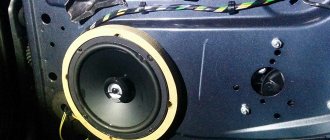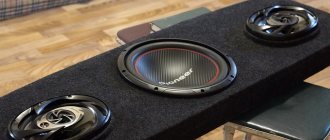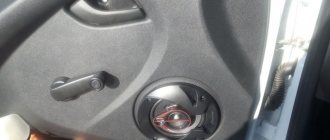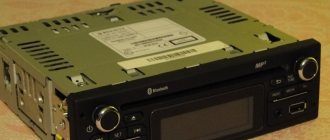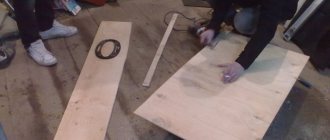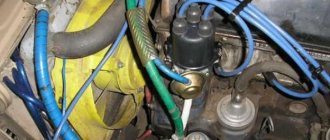Surely you know that acoustics can be coaxial and component. And if you are not sure which one to choose, if you want to learn about the difference between these types or how to carry out the installation correctly, then this material will be useful to you.
The main difference between coaxial speakers and component speakers is their form factor or design. In principle, this is where the pros and cons come from. The name of coaxial speakers comes from the Latin words CO - joint and AXIAL - axis. The name speaks for itself, because here there are two or three speakers together on one axis - high-frequency and mid-bass and/or mid-range. In component acoustics, they are separated and are separate elements - components. We've sorted out the names.
The answer to the questions - which is better, which type is preferable to improve the sound of music in the car and what to buy - is simple. These are component acoustics, but not in all cases. Read on if you want to find out why.
Nuances when choosing
Now about which coaxial speakers are better
When choosing acoustics, you should first pay attention to the manufacturer. Little-known brands do not always produce high-quality products
You should also look at the materials used to make the speaker cones. Low- and mid-frequency speakers sound best when their cones are made of special paper rather than any other materials. As for high-frequency elements, the best option here is a silk diffuser.
Another nuance is the sensitivity of the speaker. The higher this indicator, the better the sound volume.
In high-quality Hi-End coaxial acoustic systems, the crossover is made remote to obtain high sound quality.
Finally, let’s look at what to choose – coaxial or component speakers. It is worth noting here that each of these systems has its own purpose, and they complement each other. If the car does not have any acoustics at all, then after installing only coaxial speakers it is impossible to get good sound. But installing only a component system will not provide surround sound. Therefore, it is recommended to install both of these systems on the car, and subsequently the acoustic system can be improved by installing additional component speakers and better coaxial speakers.
Types, design features
Let’s immediately figure out what types of speakers the market offers for these products and what their differences are. There are two types:
- Coaxial acoustics;
- Component acoustics;
First, what does coaxial acoustics mean? To put it simply, these are speakers that combine elements with different sound frequencies in one device. In component speakers, each speaker with its own frequency is installed separately.
Infinity coaxial speakers
The design of a coaxial speaker is as follows: there is a low-frequency speaker (quite large), in which smaller heads (aka strips) are installed on one axis, and they sound in the mid and high frequencies. Additionally, the design includes a crossover - a block of filters that divide the frequency range among themselves. It is the design features that distinguish coaxial acoustics from other types.
The number of installed heads can be very different, but the most common is 2- and 3-way coaxial acoustics, in which the speakers included in the design reproduce sound at low, medium and high frequencies. You can even find 5-way speakers, but in reality, so many heads are of no particular use.
This is where the next question arises: coaxial or component acoustics - which is better? It is impossible to answer unequivocally here, since each of them serves a specific purpose. Essentially, these two types of speakers have the same components, but in the case of a component, they are separated.
Advantages and disadvantages
The main advantages of “coaxial” are:
- Easy to install. Their design includes elements that reproduce all frequencies, while only two terminals are used for connection. In the case of a component system, each speaker must be connected separately;
- Due to the somewhat simplified design, the cost of coaxial acoustics is somewhat lower, which is often the main factor when choosing equipment for a car;
- The market offers this type of acoustics with a wide variety of dimensional parameters, which allows you to choose the optimal model for any car;
But they also have quite a few disadvantages:
- Very often the manufacturing quality of such speakers is not up to par, especially from little-known manufacturers. As a result, they can break very quickly;
- Coaxial car speakers are very sensitive to dust and debris. Getting between the heads, dirt leads to a severe deterioration in sound quality;
- Often the number of stripes does not correspond to reality. That is, outwardly everything looks like there are several heads installed on the low-frequency speaker, but in reality there is only one head, and the rest is a fake;
- On inexpensive models, a capacitor acts as a crossover, which naturally affects the sound quality.
It is noteworthy that some manufacturers produce combined acoustic models. That is, there is a set of different-frequency speakers included in the component system. But it is possible to install high-frequency heads on a low-frequency speaker and secure them using special latches, resulting in a coaxial type.
Component acoustics
Component acoustics consists of several speakers , there may be two of them, then this is a two-component system, or maybe three, in which case this is a three-component system. As a rule, such acoustics are installed at the front of the listener.
Speakers for a component system can be selected separately or purchased as a ready-made kit. It should be noted here that all components in the kit are balanced with each other. If you want to purchase speakers separately, you will need to take into account their frequency ranges and select a crossover .
A crossover is needed in order to divide the signal between different speakers and send high frequencies to tweeters or high-frequency speakers (HF), and middle frequencies to midbass or midrange.
One of the advantages of component acoustics is that they can be correctly positioned in the car. This complicates installation, but significantly improves the sound quality of the system.
Due to their characteristics, high-frequency speakers have a narrow directivity , that is, undistorted sound propagates close to the direction axis. Therefore, they need to be placed facing the listener, approximately at the height of the head (ears).
HF installation example
Then you get the highest quality and detailed high-frequency sound that these tweeters can provide. They are usually installed in the corners of the side mirrors or in the windshield pillars.
Example: HF in the corner of the mirror
In three-component acoustics, the midrange speaker (MF) has a sound propagation angle that is not much greater than that of the tweeter, so its directionality is also very important. They are installed according to the same rules, usually together with tweeters.
Example of setting midrange and treble
In midbass, the sound spreads much wider. Therefore, they are suitable for installation in a standard place in the door. True, to maximize the impact of good sound, they are slightly turned towards the listener, giving better directionality. This is exactly why podiums are made or door cards are remade.
Video
Read our articles, learn new things, listen to high-quality music with excellent bass!
As you know, all acoustic systems (AS) can be divided into 3 groups: 1). Active multiband (2 or more bands)/active filtering. In such speakers, the division of bands is carried out before the PA, then each amplifier amplifies only “its own” frequency band and is loaded onto one/group of heads of the same type. In many respects, this design option provides the highest quality sound, but in practice its implementation is expensive (the number of PAs is required according to the number of bands), requires individual configuration and, in the case of active acoustics, in which the PA is located inside, is difficult to modernize. 2). Passive multi-way speakers. Perhaps today this is the most common type of speaker. Most of these are 2- and 3-way systems; they are connected to the output of the power amplifier, and the passive filter built into the speakers takes care of the head section. The main problem with multi-band acoustics, in my opinion, is the presence of this very filter. A passive crossover, apart from fulfilling its immediate task (allocating each head its own range), does not add anything good to the sound. The phase response and impulse response of the system deteriorate, serious distortions are introduced, etc. Moreover, despite the presence of various options for constructing filters, any of these options is essentially a compromise, improving one thing but worsening another (a classic example is the Zobel circuit). The result of the sound of such a speaker is either a flattened, cleaned-up sound, or an uninteresting, boring sound, or a combination of one and the other. However, due to convenience, ease of operation and accessibility, as well as the virtual absence of an alternative, it is this type of speaker, as I noted, that is most widespread today. 3). Wideband speaker. The oldest design in which there is no division into bands, and the emitter is a broadband head designed to transmit the entire frequency range. Wideband speakers have their pros and cons compared to multiband systems. The disadvantages include uneven frequency response (including, as a rule, an unpleasant surge in the 2-3 KHz region, weak lows and “overwhelmed” high frequencies), high directivity at mid/high frequencies and modulation of mid/high frequencies by low ones due to diffuser oscillations. Nevertheless, despite its obvious and noticeable shortcomings, the single-head design finds a decent number of its fans. Its advantages include the absence of phase distortions, the closest design to a point source and the absence of elemental distortions (since there is no filter itself). In addition, the design of a wideband speaker is simpler, since there is no need to configure a crossover (active or passive). There is also a magical side - supporters claim a certain “musicality”, “airiness” and “involvement” of the sound of such a speaker.
Results
Coaxial acoustics : ease of installation, relatively low price, but the sound quality is lower compared to component acoustics. It is better to use it for sound in the rear area of the car, if needed. Common installation locations are rear doors or rear parcel shelf.
Component : costs more, requires an installation approach. But the sound quality is much higher. Has ample customization options. Installed from the front of the listener.
Primary introductory
To begin with, it would be nice to understand that no matter what kind of speaker system you like, it will still be a layout diagram, which is not only a car radio and a pair of speakers, but also an amplifier, a changer, a subwoofer, a lot of wires and mounting devices (example in the next photo).
The difference between component and coaxial acoustics
Coaxial acoustics
The difference between coaxial and component acoustics
Judging by the increasing price factor, the first on this list is an ordinary wideband speaker.
Next on the list is a coaxial speaker for a car radio, whose advantage over a broadband speaker is its greater coverage of the audio frequency range. The design feature of the coaxial speaker system itself is as follows:
- There are several speakers in one housing;
- Reproduction of sound vibrations of various frequencies is divided into areas;
- To separate the electrical signal going from the “head” to the speaker, a special filter is used - a crossover* (in more “serious” models it is carried out in a separate housing, in more “simple” ones an ordinary capacitor is used as a filter).
A crossover is a “capacitor-inductor” circuit, the purpose of which is to separate certain values of the entire frequency spectrum along audio tracks. It is used in both component and coaxial speaker systems.
Advice! Choosing the right filter components plays a huge role in the sound of the entire speaker system.
The main advantage of a coaxial acoustic system is that, without having a large sum of money on hand, it is quite possible to assemble a decent version of the acoustic layout circuit for yourself. And what’s more, installing this system will not cause any difficulties for the car owner; all installation and connection work can be done with your own hands in several stages:
- We install new equipment in its standard place (more expensive modifications, as a rule, are installed non-standardly, on a pedestal, etc.);
- We connect the speaker output directly to the radio itself or to a signal amplifier.
The disadvantages of the system described above include, despite the praise described above, the sound quality, which is somewhat away from the ideal parameters. The thing is that one speaker simply physically cannot clearly reproduce the entire spectrum of sound; frequency mixing is inevitable, which affects the sound quality.
Component acoustics
What is the difference between coaxial acoustics and component acoustics?
A component speaker system looks more favorable in terms of sound quality and undistorted frequencies, in which each speaker reproduces exactly its own frequency range and is connected to its own individual channel of the car radio/amplifier, due to which the entire acoustic circuit works harmoniously and its components do not interfere or interrupt each other.
- The price for this type of acoustics is much higher;
- High demands on the car radio itself (see Compare car radios and choose the best), the prices for which are also “biting” (having connected all the professional “stuffing” to an ordinary “head” you are unlikely to become a connoisseur of good sound);
- Difficulties of installation (it will be somewhat problematic to correctly distribute the frequencies and install the speakers in the car with your own hands, although who knows, it’s not gods who burn the pots, and there are plenty of video instructions on the Internet...);
- In most cases, it will not be possible to avoid the use of additional soundproofing materials in the car interior.
Canton Chrono 503.2
The best component acoustics in a car
Chrono 503.2 is a real German speaker: excellent workmanship, 100% quality control of each copy, Made in Germany. Despite the stated glossy finish, the speaker is covered with film, and only the front panel is made glossy. The size of the speaker is not very large, but the speaker managed to accommodate an impressive 180 mm. Of course, it is equipped with the traditional Canton aluminum diffuser. The suspension is made in the shape of a wave for the most linear and long piston stroke of the diffuser. The 25mm tweeter dome is made from a very lightweight but durable aluminum and magnesium alloy. For reliability, it is protected by a metal grill. There are two threaded holes on the bottom for mounting on a stand or bracket.
Bookshelf speakers Canton Chrono 503.2
SoundThe musical material is presented very carefully. The frequency balance is almost perfect. The timbres of instruments are transmitted with high reliability, and small details are not lost sight of. There is no increased emotionality, but thanks to a wide and smooth dynamic range, the speakers manage to accurately convey the musical idea of the composition. The bass is collected, neat, exactly in its place. However, it is not very deep, and at low volumes it loses its position even more. At first it seems that there are too many high frequencies, but they appear exactly when you really need them, and in the right quantities. The upper register is very clean, which fans of modern electronic music will certainly appreciate.
Measurements
The frequency response is smooth, although it depends quite strongly on the listening angle - the directivity of the speakers is relatively narrow. The THD is very low and there is good headroom at low frequencies. Impedance is unstable.
Specialized speakers
Reproducing sound in conditions other than indoors requires the use of speakers that take this specificity into account in their design. Speakers for landscape, mine, and marine applications must withstand high levels of dust that can penetrate the magnetic gap, prolonged solar radiation, high humidity, exposure to sea salt and other negative factors. To achieve this, major changes are made to the design: materials are selected and vulnerable elements are protected.
Magnat Quantum 753
The speaker from Magnat's mid-priced Quantum 750 line looks solid. The front wall is made thick (40 mm) to radically combat body resonances. A solid 30 mm thick podium also emphasizes the solidity of the structure. It is curious that the front panel and podium are polished to a shine, while the rest of the surface of the case is matte. The F-max tweeter is equipped with a dome made of a double textile compound and has an extended operating frequency range. The midrange/bass speaker diffuser is made of ceramic/aluminum. The voice coil is well ventilated. The aluminum speaker basket design is optimized for optimal airflow and reduced resonances.
Bookshelf speakers Magnat Quantum 753
The bass reflex port with a large horn is located on the rear wall. The crossover is optimized for signal phase and amplitude and is assembled from selected high-quality elements.
Sound The speakers play emotionally, dynamically, quickly. At the same time, the timbres of instruments are perfectly conveyed, and the musical scene is not obscured by extraneous sounds - they are pure and deep. Sound source localization is excellent. The detailing is also at a high level.
The HF level is enough for an open sound with the presence of airiness, and at the same time the upper register is very neat and unobtrusive.
Bass of medium depth, collected and fast. There is a little lack of physicality and density of presentation. At low volumes, the enthusiasm of the speakers is lost, the emotionality fades.
Measurements
The unevenness of the frequency response is minimal, but the frequency imbalance towards the HF is obvious. The SOI varies within 1% and noticeably depends on the volume, but no obvious resonances are noted. Good SOI margin at low frequencies. Impedance is unstable.
How to install a sound system
Coaxial devices are located in the rear parts of the cabin. On rear shelves or doors. Simpler options are installed in panels at the front. But you need to understand that it is not recommended to overload the front panels. If you want to connect sound to the front of the car, the elements are mounted in the front doors.
Sound system installation
The best coaxial acoustics should please not only the driver, but also the passengers
Therefore, the quality of the system is very important. Setting up effective sound is easy
And many do the work themselves. There is no need to carry out complex calculations or make special podiums. This does not affect the sound quality.
By following the following recommendations, you can complete the installation without difficulty.
- Select speakers with the appropriate diameter. If the colonies are not commensurate with the holes, use adapter rings.
- When connecting sound to a car, you need to know the power characteristics of the radio and speakers. Also, choose your amplifier wisely.
- The energy source for the car's electronics is its battery. Therefore, keep in mind that with a large number of equipment, there will not be enough power. The likelihood of stalling at the wrong time increases. To solve this problem, capacitors are installed. Devices reduce electricity consumption.
- To secure the speakers, a wooden spacer ring is made.
- The rear shelf of the car is designed for speakers. To secure them, you need to remove the shelf. Only proper fastening will prevent the elements from creaking and rattling.
- Wires are selected separately. It is better to buy them with sections up to 4 mm. Wires are included with the system, but it happens that they are not suitable for power and can only be connected to low-power heads (up to 20 W). If you connect wires with a small cross-section, you will not get high-quality sound and normal operation of the speakers.
- Before you start connecting elements and wires, check all items for proper power.
Speakers for cars
Triangle Color Bookshelf
Very nice-looking speakers from the French manufacturer Triangle are available in three lacquer colors - white, black and red. The Color line stands out with its bright, cheerful style among all Triangle products and takes its place as the entry-level line.
The bookshelf model uses a tweeter with a titanium membrane and a midrange/woofer with a paper cone. In general, the speaker is quite interesting; its suspension is wide, corrugated and basically made of fabric. The paper diffuser is coated with a special compound. The dust cap is designed in the shape of a bullet. The design of the crossover uses developments from the top Magellan line. The bass reflex port is located on the rear wall of the speaker.
Bookshelf acoustics Triangle Color Bookshelf
Wharfedale Jade 3
The British company Wharfedale traditionally spares neither effort nor materials even on budget lines. And the Jade 3 model once again confirms this. In our test, this is the largest and heaviest shelf speaker, and the only 3-way one. A body with curved walls is a feature of the top lines of many other manufacturers, but not Wharfedale. Both the body shape and the additional bulkheads make the body as acoustically inert as possible, preventing unwanted sound coloration. High frequencies are handled by an aluminum dome tweeter. At the border of 3 kHz it is replaced by a midrange speaker with a diffuser made of aluminum-cellulose composite. And already in the region of 350 Hz, the initiative is seized by the woofer, equipped with a woven diffuser made of a mixture of carbon and fiberglass. The combination of such materials with a braided structure brings the diffuser closer to an ideal piston, eliminating the problematic resonance phenomena inherent in metal diffusers.
Bookshelf speakers Wharfedale Jade 3
The speakers operate in a closed volume. The crossover for the speaker was optimized on a computer for maximum linearity of signal phase transmission.
Sound Wharfedale speakers sound traditionally beautiful. All instruments are clearly arranged spatially. The music stage is clean and spacious.
The speakers deliver bass carefully, not forcefully, as if they are afraid of damaging the balance of the overall sound picture. The same can be said about upper case.
The softness of the presentation of musical material is interestingly and harmoniously combined with excellent sound detail. In addition, the speakers play very well at low volumes.
Measurements
The frequency response of the model is flat, but at high frequencies it behaves in a peculiar way - a decline and a sharp rise. The bass is deep. The SOI is almost perfectly flat and extremely low. Very solid headroom for low frequencies. The impedance is quite stable.
The loudspeaker is a group emitter.
About the design and operation of the car What is better than Lada Priora or 2112. What is better than VAZ2112 or Priora. Calculations and miscalculations
A group emitter is a set of similar dynamic heads placed in the same plane at a certain distance from each other and connected to each other in phase, series or parallel, or series-parallel. To ensure good performance of a group radiator loudspeaker, it is necessary that all heads are of the same type and the same power is supplied to each head. Failure to comply with these requirements or disruption of the in-phase operation of the heads reduces the efficiency of the group emitter.
The widespread use of loudspeakers of this type abroad is due to several reasons. The first is that using several low power heads you can create a high power loudspeaker. Thus, a Swedish amateur radio magazine published descriptions of amateur loudspeakers containing up to 6-8 similar broadband heads of 20 W each. Such speakers can work with amplifiers with output power up to 100-200 W.
Another reason for the proliferation of group emitters is their inherent improvement in output at medium and especially the lowest frequencies. This improvement is due to an increase in the opening area of the diffusers, proportional to the number of heads. At the lowest frequencies, this increase is 6 dB for four heads, 8 dB for six and 9 dB for eight. Due to this, the bandwidth of effectively reproduced frequencies is expanded into the region of lower frequencies by about a third or half an octave compared to the bandwidth of a single head in the same design.
The third reason is that the depth of the cabinet box of such a loudspeaker can be 1.5-2 times less than a loudspeaker with a single head, i.e. the group emitter can be quite flat and can be placed on the floor near a wall or even hung on wall.
Let us dwell on two design options for a group radiator type loudspeaker containing four dynamic heads of 6 W each. In these loudspeakers it is most convenient to use low-frequency drivers of the 6GD-2 type. When the hole diameters are reduced, it is possible to use heads like 4GD-4 or 4GD-7, 4GD-av. 4GD-35, 4GD-36. Preference should be given to the first and last two heads.
The design of the housings of both options is shown in Fig. 3,a,b. The housings are made of chipboard 20 mm thick. The parts are assembled using screws and glue. The difference between the options lies in the shape of the front wall: in Fig. 3, and it is flat, in Fig. 3.6 - slightly folded in the middle. Both designs have approximately the same characteristics in the low-frequency region. The results of the calculations carried out by the author are shown in Fig. 4, from which it can be seen that a noticeable increase in the output of the heads with a distance between the centers of their diffusers equal to 260 mm is observed starting from a signal frequency below 600 Hz.
The main advantage of a loudspeaker with a broken front panel (Fig. 3, b) is a slightly better uniformity of radiation at mid and high frequencies in both planes. In a loudspeaker with a flat front panel (Fig. 3a), on the contrary, the radiation pattern at these frequencies narrows.
Group radiators have been widely used recently; they are often used as low-frequency radiators in systems with several signal frequency division bands. Such systems, designed for input power up to 50-100 W or more, are widely used for sound stages, dance halls and discos.
Foreign amateur radio designs. Moscow, Radio and Communications, 1982.
The acoustics we live with → ← The best is the friend of the good
Thinking out loud, comparison
Unfortunately, at the moment there is no manufacturing company that would produce ideal component speaker systems; each has its own advantages and disadvantages. And if we assume that the car radio spends most of its working time broadcasting, then a reasonable question arises about the advisability of such high material costs. The ordinary wideband speakers already installed by the automaker will be sufficient, since no acoustic system will be able to qualitatively reveal the deep bass and high frequencies of your favorite radio station. The main difference between coaxial acoustics and component ones is that the coaxial one plays from one point, while the component one plays from the same point as its speakers. As for the playback range, in both cases it is divided into several parts, but in both cases the “high-frequency speakers” do not interfere with the propagation of low-frequency waves. In principle, the speakers in both cases should be as close to each other as possible, this condition is especially true for “high-frequency speakers” connected in a three-way system. Speaker systems differ in the number of connected speakers and sound reproduction formats (implemented by combining several acoustic systems):
- Two-way includes LF/MF (midbass) and MF (tweeter) speakers;
- Three-way - adds another midrange speaker.
The number of bands is determined by the crossover - the number of bands is equal to the number of input speakers:
- Stereo format (2-channel) – a pair of front wideband speaker systems;
- Dolby Surround, surround sound (4-channel) – a pair of front + a pair of rear systems;
- Presence effect, 5.1, Dolby Digital (6-channel) - a pair of front + a pair of rear + central system, as well as a subwoofer.
In addition, it is necessary to take into account the physical size of the speakers, since the sound quality of speakers operating in the low and mid-frequency regions greatly depends on the size of the case (acoustic design). For example:
- To reproduce “deep” bass, it is recommended to install 16-17 cm speakers (but even with such “pancakes” you will not be able to keep up with the most ordinary subwoofer, which is simply irreplaceable at low frequencies);
- The speaker sizes of 10, 13 and 16 centimeters are designed for a volume equivalent to a car door, which involves their installation in the door body (there are exceptions, you need to look individually at the installation recommendations, which can sometimes simply be printed on the packaging box);
- Due to its small size, the high-frequency speaker should not be treated with disdain; it plays a very important role in the entire acoustic layout.
